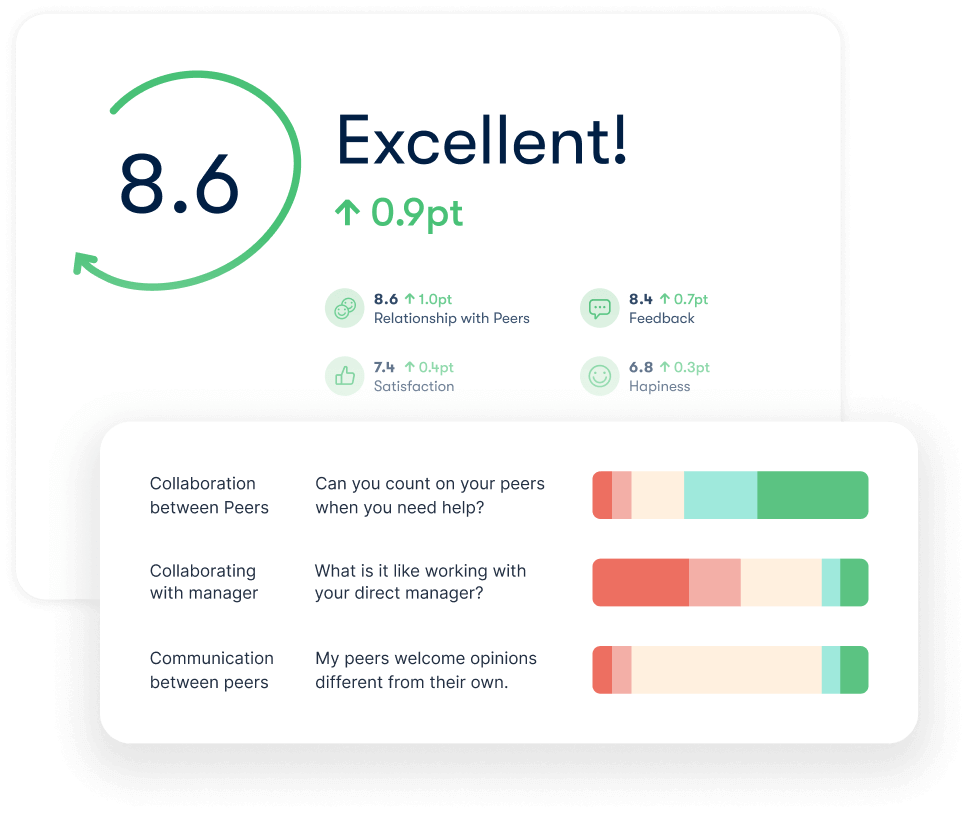Even with everyone in the office, it can be difficult for managers to keep up with their teams. How are people feeling? What are the current challenges? And what's going really well? These are things every great manager wants visibility on. But it can be hard to understand your employee's experience, especially when you have a distributed or remote team.
This is why the benefits of Pulse Surveys are particularly helpful for managers with distributed teams. Pulse Surveys help you see the whole picture of your team's engagement levels, stress and wellbeing, professional development, and more. They offer detailed insights into the employee experience on your team.
By gaining this high-level view of what's really going on, you're better able to take action for your team where it will have the greatest impact.
In this article...
What are Pulse Surveys?
Quick history lesson: Over the last 20 years, managers and leaders alike have come to understand that checking in annually, quarterly, or even monthly with employees is simply not frequent enough. Pulse Surveys were originally introduced as an alternative to an annual engagement survey, and now they're widely considered the gold standard for measuring employee engagement.
Sent on a weekly or bi-weekly basis to employees, Pulse Surveys are designed to be quick, simple, and integrated into the flow of work. The data they collect are presented in clear, digestible reports, so you can measure and analyze engagement levels easily. Plus, historical insights allow you to track trends over time.
See the whole picture with Officevibe Pulse Surveys
In the Officevibe Pulse Survey software, employees are sent anonymous 5-question surveys every week or two. Follow-up questions allow for open-ended feedback, and Custom Surveys offer the opportunity to dig deeper into specific areas.
Simple graphs break down the data for managers into 10 Metrics of Engagement, with 26 Sub-Metrics and expert-crafted questions backed by Deloitte. So it's easy for you to see how your team is doing at a glance, no matter where you are—or where they are.

The benefits of employee Pulse Surveys
Maintaining a pulse on your employees’ engagement and collecting their feedback is an essential part of modern management. It helps you improve team performance and employee engagement—not to mention spot any issues that arise early, so you can take action before things take a turn for the worse or good employees leave.
Benefits of employee surveys for all teams
- Give employees a safe space to share their honest feedback.
- Gain valuable insights on various factors or metrics of employee engagement.
- Show employees that their ideas, opinions, questions, and concerns are valued.
- Understand what's going on currently on your team, and adapt in real-time.
- Foster a feedback-positive culture and spark conversations that wouldn't happen otherwise.
Check out our top 10 benefits of employee engagement surveys.
Pulse Survey benefits for distributed or remote teams
Before we get into the benefits, what exactly is a distributed team? A team qualifies as distributed when its members work in different physical locations. Distributed companies can have a head office, but employee presence is not necessarily mandatory.
- Maintain your 'open-door policy' and be available for remote employees.
- Get a better view of the unique challenges of your distributed team.
- Spot warning signs of misalignment, conflict, or burnout on the team.
- Create a virtual safe space for honest feedback about employee experience.
- Check in on things that might get missed away from the water cooler.
Like checking your online banking, keeping an eye on engagement data becomes a natural, frequent reflex. You'll know where to spend more energy, and how to best allocate your resources for the overall health of your team. And this helps you maintain engagement, and reap all the benefits of a highly engaged team.
Best practices for employee Pulse Surveys
Make the most of your employee engagement surveys by following these 3 key best practices.
1. Offer anonymity
Offering an anonymous space shows employees that the goal is understanding. It lets them know there won't be any reprimand or finger-pointing for honest constructive or critical feedback. Plus, anonymity gives safety to those who are more introverted or might want to touch on more sensitive topics.
Officevibe's Pulse Survey tool provides managers with anonymized reports using aggregated data. Follow-up questions give employees the choice to toggle anonymity on or off, and managers can even turn these messages into a two-way chat while employees stay anonymous.
2. Share results
Share your team's results with them. They're likely curious, and this is a great way to be transparent with your team, let them know how you plan to take action, and ask them for their ideas. You can do this on a monthly or quarterly basis, or any time you notice a metric trending up or down.
Once you've shared your report with the team, bring up their engagement results in your one-on-one meetings, too. Officevibe’s hybrid work software makes it easy to turn engagement metrics into talking points, so you can check in on everyone’s individual perspective.
3. Follow through
The cardinal rule of surveying employees is to follow through on the results. Showing that you're willing to create an engagement action plan builds trust with your team, which can reduce turnover and boost productivity. When you collect ongoing employee feedback, you can implement incremental change. This is more sustainable than attempting a total overhaul after sifting through a mountain of annual employee survey results.
Get your team to pitch in on planning how you'll follow through on survey results. Together, you can decide which metric you want to focus on and brainstorm solutions to address what isn't working or amplify what's already going well.
💡Read more about employee engagement survey best practices here.
Sample Pulse Survey questions
It's great to ask questions on a wide range of topics in your survey, and then dig deeper where you see issues or inconsistencies. These sample Pulse Survey questions are from the Officevibe survey bank, and used by over 50,000 managers worldwide. You can also use an employee survey template for simplicity.
- Do communications among peers feel honest?
- How would you rate the importance that your organization gives to your opinions and suggestions?
- Do you feel that your direct manager understands your day-to-day reality?
- Is recognition meaningful when you receive it?
- Do you feel you have enough freedom to decide how you do your work?
- Overall, how do you feel about your level of work-related stress?
- Do you know what you need to do to meet your goals and objectives?
Once you've integrated Pulse Surveys into your team's feedback cycles, you can start tracking trends. Cycling through the same questions over time helps you see how things shift and understand the impact of your efforts. Just make sure your question bank is big enough, to avoid redundancy and avoid survey fatigue.
Pulse Surveys help you see the whole picture of your dispersed team
However you keep a pulse on how your people feel, collecting frequent feedback from your team will help you lead with confidence. Once you understand your employees' experience better, show them that they've been heard by implementing meaningful change.
